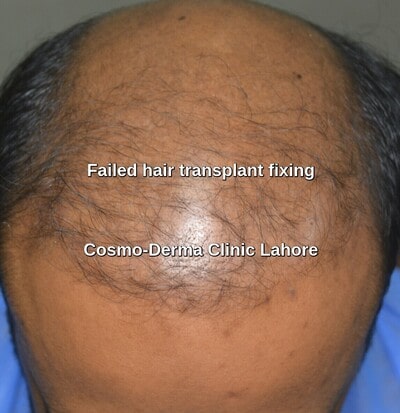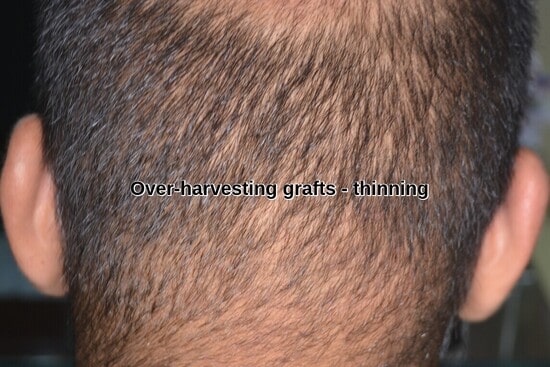Hair transplant complications that arise as a result of surgical procedure for the treatment of baldness when other medical modalities of treatment have not provided desired results to the patients. Although the procedure is quite safe and gives effective results too, it can give a few problems that can have an impact on a patient’s health, both physically and psychologically. Regarding this, the surgeon performing the procedure should be well informed about all the possible side effects that can happen as the result of this procedure. The surgeon should also employ methods that are best known to have reduced the incidence of side effects and difficulties as a result of surgery, since the best treatment for any problem is the methods and techniques that are used to prevent the complication from happening in the first place. Most of the these happening as a result of surgery are avoidable, provided good pre-operative preparation is done, good surgical technique is employed and good post-operative wound care methods are employed. Regardless of the severity, all the patients undergoing the surgical procedure should be well aware of all the possible results and counselled about the risks and benefits and methods available to reduce the hitches. Every patient should be properly counselled and care should be taken to minimize the incidence of side effects to zero.
Hair transplant complications common reasons
As with other surgical procedures, this can also result in hair transplant complications. As the demand for the procedure increases due to the limited number of medical treatment options available, doctors from different specialties, with inadequate training are performing these surgeries that have eventually resulted in an increase in the number of problems. The number of side effects can vary depending on the pre-operative preparation of the patient, the surgical technique used and the accuracy of the technique and the post-operative care provided to the patient in the hospital and the instructions provided to the patient about how to take care of newly transplanted hair and the donor site at home. Complications that can arise can be divided into following categories: general, donor area (follicular unit transplant and follicular unit extraction) and recipient area.
General hair restoration surgery side effects
Anesthesia side effects include allergic, idiosyncratic, toxic or psychogenic reactions to local anesthetic agents. Intraoperative complications may include tachycardia and fluctuations in blood pressure, that can be a risk factor of a patient with already compromised cardiac function and patient having other comorbidities. So, it is essential to do adequate preoperative preparation of patients to identify any risk factors and monitor the blood pressure and heart rate of the patient during the whole procedure. Syncope occurs as a common postoperative complication, especially if the procedure took too long, due to postural hypotension, local anesthesia effect, decreased blood glucose levels, poor hydration status and electrolyte imbalance. It is important to maintain a good hydration and electrolyte status in patients during the procedure. Pain is also a common side effect occurring both during and after surgery. It can be minimized by providing proper analgesia to patients during and after surgery. Field block anesthesia technique using local anesthetic and adrenaline mixture, is the standard technique used to provide pain relief. In addition to this, ice packs can also be used. Postoperatively, nonsteroidal anti-inflammatory drugs prove effective for the relief of pain. Postoperative edema at the recipient site can be reduced using oral steroids. Postoperative itching at both donor and recipient site can be countered by using saline spray for three to four days, multiple times. Oral antihistamines can also be prescribed. Postoperative hiccups are rare but can be a cause of significant discomfort for the patient. Infection can occur at both donor and recipient sites, due to poor hygienic conditions of preexisting comorbidities of the patient. High tension closure at the donor site can also cause infections. Prophylactic antibiotics should be prescribed and good counselling of the patient regarding the importance of hygienic measures in preventing the incidence of infections should be done properly. If infection occurs, then local and systemic antibiotics must be prescribed depending on the severity of infection.
Hair transplant complications occurring after follicular unit transplant at the donor site include donor site wound dehiscence, rare because of good vascular supply of scalp, but can occur because of the circulatory compromise as a result of comorbidities of the patient, high tension closure of donor site, early suture removal and excessive physical activity by patient in early postoperative period. Necrosis and wound dehiscence can result due to non-healing or delayed healing, resulting in destruction of soft tissue along with the follicles. Donor hair effluvium also called as donor shock loss, may be seen below and above the incision line and is most of the times temporary with complete recovery in about three to four months. Scarring can also occur. It can be a wide scar, visible scar, crosshatch scar, keloid or a hypertrophic scar. Hyperesthesia and continuous pain can also be a complication at the donor site, resulting from damage to nerves supplying the donor site while making deep incisions. Hematoma may form at the donor site, due to deep incisions as a result of transection of a major artery. Suture extrusion can also occur.
Hair transplant complications occurring after follicular unit extraction at the donor site are less common. Donor site depletion may occur as a result of destructive and non-uniform picking of grafts from the donor site. Pinpoint scarring occurs because of the punch used in extracting follicles. Postoperative effluvium may appear several weeks after surgery with diffuse hair loss. It usually results from over-harvesting of grafts from the donor site or impaired blood supply to the donor site. Buried grafts occur mostly in areas where blunt punches are employed. Over harvesting leads to permanent damage to the donor site with thinning and patches. Necrosis can also occur after surgery but is rare. Subdermal cysts are common and multiple cysts, that are painless, grow at the donor site.
Recipient area can also show some hair transplant complications. Chronic folliculitis can occur because of unhygienic measures or preexisting skin conditions of the patients. Treatment with topical and systemic antibiotics must be done vigorously with daily hygienic measures with usage of antibacterial shampoos to prevent permanent damage to the follicle. Growth of the grafted follicles may be poor because of poor dissection technique used and traumatic placement of follicles. Patient factors like smoking, diabetes etc. can also result in poor growth. Painful and erythematous cysts might form at the recipient site because of slippage of graft under the skin. Recipient area might have a poor or unnatural looking hairline because of poor surgical planning. Edema, bleeding, central scalp necrosis, shock loss or recipient site effluvium, arteriovenous fistula and aneurysms might form at the recipient site.
How to prevent hair restoration surgery side effects
Most of the hair transplant complications are preventable, only if utmost care is given to the patient and the procedure is carefully planned and executed with great expertise and surgical skill. Preoperative screening of patients and paying attention to preexisting disease as well as the patient’s preoperative preparation is very important for the success of surgery. Likewise good surgical techniques and maximum postoperative care should also be provided to the patient to minimize the risk of complications and improve the results.
People also search
| Best hair restoration in Pakistan | Temporary hair loss |
| Female hair fall treatment in Pakistan | Permanent baldness solution |
Ask a doctor | Write us or WhatsApp | +92-333-430-9999



